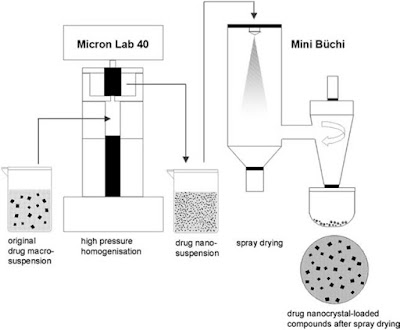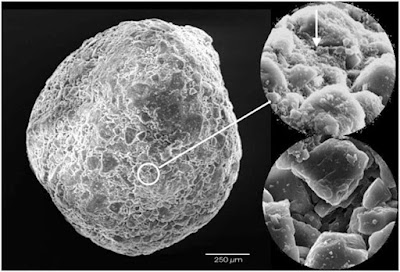Introduction of Nanoparticles
The introduction of nanotechnology in medicine is the pharmaceutical approach to formulating drugs as nanoparticles for diagnostic and curing diseases in a targeted drug delivery system. Nanotechnology is considered to be at a size below 0.1 m or 100 nm (a nanometer is one billionth of a meter).
Nanoparticles are potential drugs which in low amount produces rapid onset of action by enhancing solubility through an increased rate of dissolution. Based on the uptake of murine macrophages nanoparticles has an optimal size range of 10-250nm and surface range between -10mv and +10mv.Nanotechnology in medicine emerged as two branches, Nanodevices, and Nanomaterials where Nanodevices act by respirocytes.
Nanomaterials classified as polymers and non-polymers [1].Polymers are nothing but the carriers which carries the medicine to the targeted site further which releases drug by a slower disintegration of itself. Due to this specific drug delivery system nanomedicines have gained much interest in the field of cancer, angiogenesis, diabetes, inflammation and Nasal vaccine delivery.
TYPES OF NANOPARTICLES
Nanoparticles are classified into three areas:
1.One dimensional (eg: optical fiber optical system),
2.Two dimensional (Carbon nanotubes)
3.Three dimensional (Dendrimers, Quantum dots, Fullerenes).These can be characterized by SEM and TEM analysis.
FORMULATION OF NANOPARTICLES:[1,2]
SOLVENT EVAPORATION
Emulsification of polymer solution into an aqueous phase and evaporation of polymer solvent by inducing polymer precipitation as nanospheres.A biopolymer is used.
SOLVENT DIFFUSION
A water-miscible solvent in a small amount of organic solvent is used in an oil phase., a turbulence generated will form smaller particles which can be separated by increasing the water-miscible phase.
DOUBLE EMULSION AND DIFFUSION
Addition of aqueous drug solution to organic polymer solution to form w/o emulsion emulsion.which is further exposed to an aqueous solution to form w/o/w emulsion.then solvent removal can be done by evaporation.
SALTING OUT METHOD
Separation of water-miscible solvent from aqueous solution by salting out effect.
The synthetic polymer is used.
PRECIPITATION METHOD
IONIC GELATION METHOD
Electrostatic interaction between the positively charged amino group of chitosan and negatively charged tripolyphosphate to form coacervate size in nanometer.
POLYMERIZATION METHOD
It is the polymerization of monomers in aqueous solution.
SUPERCRITICAL FLUID TECHNOLOGY
To prepare biodegradable nanoparticles by avoiding usage of organic solvents.
 |
| The Two-Step Process of The Production of Drug Nanocrystal Loaded Compounds |
Fig.1.The drug nanosuspension is obtained by high-pressure homogenization (Micron Lab 40) is further processed by spray drying using a Mini Bu¨ chi. Drug nanocrystals embedded in the matrix are obtained.
 |
| Fig.2.Modelling of Microparticles |
 |
| PEG, Polyethylene Glycol |
Fig.3. Capsules filled with granulated PEG 2000 containing Amphotericin-B nanocrystals (left), tablets produced by compaction of the granulate (right). Abbreviation: PEG, Polyethylene Glycol.
 |
| SEM Photograph of Nanocrystals |
ROLE OF POLYMERS IN NANOTECHNOLOGY [3]
The role of polymers in nanomedicine is very targeting every day.This is why the reason for the development of nanotechnology in medicine.Polymers are classified as:
Natural Polymers: Polysaccharides,Starch,Chitosan,gelatin,albumin.
Synthetic Polymers: Polycaprolactone (PCL), Polylactic acid (PLA).Polyalkylacrylate.
Polymeric Nanoparticles: Modification of natural polymers.eg. poly (D,L lactide), Polycyanoacrylate,poly(lactide-co-glycolide). It is comprised of the vesicular system (nanocapsules: drug is confined to a cavity surrounded by a polymeric membrane.), matrix system(nanospheres: drug is dispersed throughout the polymeric matrix). These are non-toxic and non-immunogenic in nature.
Multifunctional polymeric nanoparticles: Environmental responsive micelles, colloids,nano-hydrogel,core-shell nanoparticles.
· Unique Class of Polymers
Drug conjugates: Formed by conjugation of low molecular weight drug with a polymer.
SYNTHESIS OF BIOCOMPATIBLE POLYMERS
- Electrodropping system
- Microfluidic system
- Core-shell particulate system
- Sonication based system
 |
| Advanced Techniques of Preparation of Polymeric Nanoparticles |
Fig.5.Schematic diagrams representing the advanced techniques of preparation of polymeric nanoparticles
TARGETED DRUG DELIVERY SYSTEM[1,2]
 |
| Fig.6.Targeted Drug Delivery System |
APPLICATION OF NANOMEDICINES[4]
The use of nanomedicine is tremendous. Usage of biopolymers result in reduced toxicity and increased specificity which plays a vital role in gene delivery and vaccination.Synthetic nanometer usage leads to treatment in the field of cancer, plaque, musculoskeletal disorders, and kidney diseases. By modifying the route of administration, it helps the drug to cross BBB through nasal route.
By parenteral route using microneedles and jet injection.Through transdermal rout by skin patches, which all eliminates pain.Nanoparticles are used in the oral delivery of peptides and proteins.Nanopores used to protect transplanted tissues from host immune system.
The Niosome ability to load both hydrophilic and lipophilic drugs. Pharmacyte is self-powered computer-controlled medical nanorobot system capable of digitally precise transport timing and target drug delivery.
REFERENCES:
1. S.Bhatia, Natural polymer drug delivery system,pub.Do110.1007/978-3-319-41129-3-2pg.no.33,45.
2. Devasier Bennet &Sanghyo, Polymer Nanoparticle smart drug delivery ch-8.
3. Ssarabjeetsinghsuri, Hicham et al, Nanotechnology-based drug delivery systems, a journal of occupational medicine and toxicology, pub, Dec 2007.
4. A.P.Anconabi, m.o.emeje, recent application of natural polymers in nano drug delivery pub 2011 s4.
Figure: 1. Muller RH, Peters K. Nanosuspensions for the formulation of poorly soluble drugs: I. Preparation by a size-reduction technique. Int J Pharm 1998; 160(2):229–237.
Figure:2. Mu¨ llerRH, Heinemann S. Surface modeling of microparticles as parenteral systems with high tissue affinity. In: Gurney RaJ HE, ed. Bioadhesion—Possibilities and Future Trends. Stuttgart: Wissenschaftliche Verlagsgesellschaft, 1989:202–214
Figure:3. Peters K, Mueller RH. Nanosuspensions for the oral application of poorly soluble drugs. In: Proceeding European Symposium on Formulation of Poorly-Available Drugs for Oral Administration, APGI, Paris, 1996.
Figure:4. Jacobs C, Muller RH. Production and characterization of a budesonide nanosuspension for pulmonary administration. Pharm Res 2002; 19(2):189–194.
Figure;5. Nuxoll E. BioMEMS in Drug Delivery. Advanced Drug Delivery Reviews
2013;65(11-12) 1611-25.,
Wang Y, Byrne JD., Napier ME, DeSimone JM. Engineering Nanomedicines using Stimuli-Responsive Biomaterials. Advanced Drug Delivery Reviews 2012;64(11) 1021-1030.
Shim TS, Kim S, Yang S, Elaborate Design Strategies Toward Novel Microcarriers for Controlled Encapsulation and Release. Particle and Particle Systems Characterization 2013;30(1) 9-45.
Christopher GF, Anna SL. Microfluidic Methods for Generating Continuous Droplet Streams. Journal of Physics D: Applied Physics 2007;40(19) R319-R336.
Dendukuri D, Doyle PS. The Synthesis and Assembly of Polymeric Microparticles using Microfluidics. Advanced Materials 2009;21(41) 4071-4086.
Valencia PM, Farokhzad OC, Karnik R, Langer R. Microfluidic Technologies for Accelerating the Clinical Translation of Nanoparticles. Nature Nanotechnology 2012;7(10) 623-9.
Choi DH, Subbiah R, Kim IH, Han DK, Park K. Dual Growth Factor Delivery using Biocompatible Core-Shell Microcapsules for Angiogenesis. Small 2013;9(20) 3468-76,
Luttge R, Berenschot E, De Boer M, Altpeter D, Vrouwe E, Van den Berg A, Elwenspoek M. Integrated Lithographic Molding for Microneedle-Based Devices. Journal of
Microelectromechanical Systems 2007;6(4) 872-884, Park J, Allen M, Prausnitz M, Biodegradable Polymer Microneedles: Fabrication, Mechanics and Transdermal Drug Delivery, Journal of Controlled Release 2005;104(1) 51-66
Polymer Nanoparticles for Smart Drug Delivery http://dx.doi.org/10.5772/58422 291,
Wendorf JR, Ghartey-Tagoe EB, Williams SC, Enioutina E, Singh P, Cleary GW, Transdermal Delivery of Macromolecules using Solid-State Biodegradable Microstructures. Pharmaceutical Research 2011;28(1) 22-30.,
Raphael AP, Prow TW, Crichton ML, Chen X, Fernando GJP, Kendall MAF, Targeted Needle-Free Vaccinations in Skin Using Multilayered, Densely-Packed Dissolving Microprojection Arrays. Small 2010;6(16) 1785-1793
Figure:6. Ould-Ouali L, Noppe M, Langlois X, Willems B, Te Riele P, Timmerman
P, Brewster ME, Arien A, Preat V: Self-assembling PEGp (CL-co-TMC) copolymers for oral delivery of poorly water-soluble drugs: a case study with risperidone. J Control Release 2005, 102(3):657-668.
Kipp JE: The role of solid nanoparticle technology in the parenteral delivery of poorly water-soluble drugs. Int J Pharm2004, 284(1–2):109-122. 
No comments:
Post a Comment
We are happy that you want to comment, please note that your comment will be reviewed first before it is published.
If you like the article! You can share it with your friends and colleagues by pressing at social media buttons provided to the left of the page.
NO word verification or sign up is required!